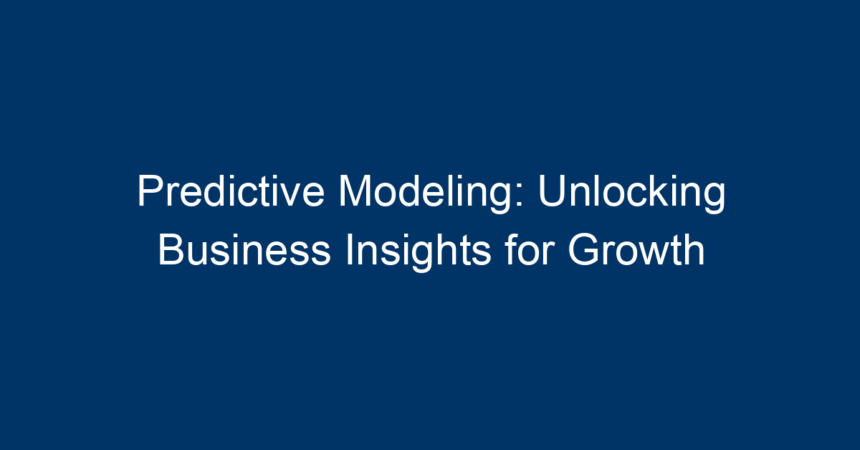In today’s data-driven world, businesses find themselves swimming in an ocean of information. The challenge lies not just in gathering this data, but in deriving meaningful insights that can drive strategic decisions. Enter predictive modeling, an analytical technique that uses historical data to forecast future outcomes. This powerful tool equips organizations with the means to navigate the complexities of business growth, improve operational efficiency, and enhance customer satisfaction. In this article, we will explore how predictive modeling can unlock invaluable business insights and position organizations for sustainable growth.
Understanding Predictive Modeling
What is Predictive Modeling?
At its core, predictive modeling is a statistical technique that leverages historical data to create a model that predicts future outcomes. By applying algorithms and machine learning techniques, businesses can identify patterns and trends that would otherwise go unnoticed. These models help organizations forecast various factors, such as customer behavior, sales trends, and potential risks.
The Importance of Predictive Modeling in Business
In an environment where making informed decisions is crucial, predictive modeling acts as a valuable compass. By analyzing past data, businesses can:
- Improve decision-making processes
- Enhance customer insights
- Optimize operational efficiencies
- Mitigate risks
- Increase revenue and profitability
With these benefits, predictive modeling transforms raw data into actionable insights, driving business growth.
Key Components of Predictive Modeling
Data Collection
The foundation of any successful predictive model is high-quality data. Collecting relevant, comprehensive, and accurate data is the first step. Businesses should:
- Identify data sources: Internal sources (sales data, customer feedback) and external sources (market trends, social media).
- Ensure data quality: Cleanse and validate data to eliminate inaccuracies.
Data Preparation
Before building predictive models, it’s essential to prepare the data. This step includes:
- Data cleaning: Removing duplicates, handling missing values, and correcting errors.
- Feature selection: Identifying the most relevant variables that will contribute to the predictive power of the model.
Model Selection
Choosing the right type of model is crucial for effective predictions. Common modeling techniques include:
- Regression analysis: Forecasting numerical outcomes based on historical data.
- Decision trees: Creating a flowchart-like model to predict outcomes based on decision rules.
- Neural networks: Using algorithms inspired by the human brain to process complex data patterns.
Model Evaluation
After developing a model, it’s vital to evaluate its performance. Key metrics to consider include:
- Accuracy: The percentage of correct predictions made by the model.
- Precision and Recall: Measuring the relevance of predictions in relation to the actual outcomes.
- ROC-AUC score: Assessing the trade-off between sensitivity and specificity.
Implementation and Monitoring
Once a model is validated, it’s time to implement it in business processes. Continuous monitoring is essential to ensure the accuracy of predictions remains high over time. Regularly updating the model with new data helps maintain its effectiveness.
Applications of Predictive Modeling in Business
Customer Segmentation
One of the most powerful applications of predictive modeling is customer segmentation. By analyzing historical purchase behavior, businesses can group customers based on similar characteristics. This allows for tailored marketing strategies that increase conversion rates and customer loyalty.
Sales Forecasting
Predictive modeling is instrumental in predicting sales trends. By examining past sales data, businesses can forecast future sales, enabling them to optimize inventory levels, manage supply chains, and make informed marketing decisions.
Risk Management
In today’s volatile business landscape, risk management is paramount. Predictive models help organizations identify potential risks, such as financial losses or fraud. By analyzing patterns in transactional data, businesses can proactively mitigate these risks, safeguarding their assets.
Churn Prediction
Customer retention is vital for sustained growth. Predictive modeling can analyze customer behavior to pinpoint those at risk of churning. By identifying warning signs early, businesses can implement retention strategies to enhance customer engagement and loyalty.
Challenges in Predictive Modeling
Data Quality Issues
While data is the backbone of predictive modeling, poor data quality can lead to inaccurate predictions. Organizations must invest in data governance and cleaning practices to ensure reliable outputs.
Algorithm Complexity
With numerous modeling techniques available, selecting the appropriate algorithm can be challenging. Businesses must evaluate their specific needs and choose models that align with their goals.
Ethical Considerations
As predictive modeling increasingly relies on customer data, ethical concerns arise regarding privacy and data protection. Organizations must prioritize ethical practices to build trust with customers.
Best Practices for Effective Predictive Modeling
Start Small, Scale Gradually
For businesses new to predictive modeling, starting with small pilot projects allows for testing and refinement. This gradual approach minimizes risks and builds confidence in predictive capabilities.
Collaborate Across Departments
Successful predictive modeling requires collaboration between different departments. Combining insights from marketing, sales, finance, and IT creates a more holistic view of data and fuels better decision-making.
Continuous Learning
The business landscape is ever-evolving, and so are data patterns. Organizations must commit to continuous learning by regularly updating and revising models. Staying agile is crucial for adapting to changing market conditions.
Conclusion: Unlocking Growth Through Predictive Modeling
Predictive modeling stands as a beacon of opportunity for businesses looking to leverage data-driven insights for growth. By harnessing the power of this analytical technique, organizations can make well-informed decisions, tailor customer experiences, and mitigate operational risks. As the landscape of data continues to evolve, embracing predictive modeling will not only enable businesses to unlock hidden insights but also solidify their competitive edge in the market.
Actionable Insights
- Invest in Data Quality: Ensure the integrity and relevance of data before building predictive models.
- Choose the Right Tools: Leverage software and platforms that facilitate effective predictive modeling.
- Foster a Data-Driven Culture: Encourage all departments to embrace data analytics in decision-making processes.
- Stay Adaptable: Regularly review and update models to reflect changing trends and business needs.
By following these actionable steps, organizations can effectively harness predictive modeling to drive growth and navigate the uncertainties of the business landscape.




